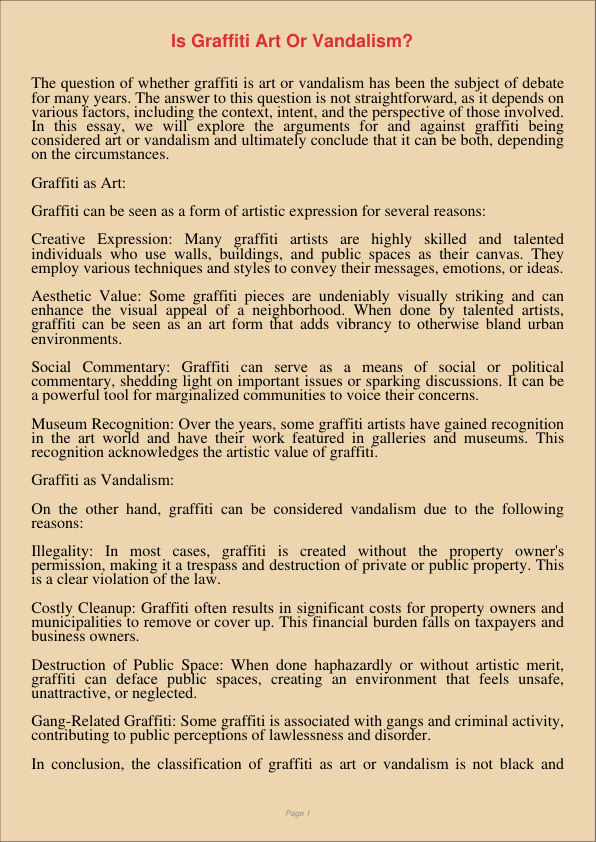Is Graffiti Art Or Vandalism
Jan 6, 2024
graffiti art
vandalism
Information Technology
Biology

The question of whether graffiti is art or vandalism has been the subject of debate for many years. The answer to this question is not straightforward, as it depends on various factors, including the context, intent, and the perspective of those involved. In this essay, we will explore the arguments for and against graffiti being considered art or vandalism and ultimately conclude that it can be both, depending on the circumstances.
Graffiti as Art:
Graffiti can be seen as a form of artistic expression for several reasons:
Creative Expression: Many graffiti artists are highly skilled and talented individuals who use walls, buildings, and public spaces as their canvas. They employ various techniques and styles to convey their messages, emotions, or ideas.
Aesthetic Value: Some graffiti pieces are undeniably visually striking and can enhance the visual appeal of a neighborhood. When done by talented artists, graffiti can be seen as an art form that adds vibrancy to otherwise bland urban environments.
Social Commentary: Graffiti can serve as a means of social or political commentary, shedding light on important issues or sparking discussions. It can be a powerful tool for marginalized communities to voice their concerns.
Museum Recognition: Over the years, some graffiti artists have gained recognition in the art world and have their work featured in galleries and museums. This recognition acknowledges the artistic value of graffiti.
Graffiti as Vandalism:
On the other hand, graffiti can be considered vandalism due to the following reasons:
Illegality: In most cases, graffiti is created without the property owner’s permission, making it a trespass and destruction of private or public property. This is a clear violation of the law.
Costly Cleanup: Graffiti often results in significant costs for property owners and municipalities to remove or cover up. This financial burden falls on taxpayers and business owners.
Destruction of Public Space: When done haphazardly or without artistic merit, graffiti can deface public spaces, creating an environment that feels unsafe, unattractive, or neglected.
Gang-Related Graffiti: Some graffiti is associated with gangs and criminal activity, contributing to public perceptions of lawlessness and disorder.
In conclusion, the classification of graffiti as art or vandalism is not black and white. It is a complex issue with various nuances. Graffiti, like any other art form, varies in quality and intent. While some graffiti undoubtedly displays artistic merit and contributes positively to urban culture, other forms of graffiti can be destructive and illegal. Society must consider these factors and seek a balanced approach that allows for artistic expression while maintaining respect for public and private property rights.
Many communities have tried to address this issue by designating specific areas for legal graffiti or creating mural programs that invite artists to beautify public spaces with their work. Striking a balance between recognizing graffiti as an art form and discouraging vandalism is essential for fostering a more harmonious and creative urban environment.